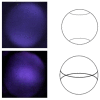Automatic Refractive Error Estimation Using Deep Learning-Based Analysis of Red Reflex Images
- PMID: 37685347
- PMCID: PMC10486607
- DOI: 10.3390/diagnostics13172810
Automatic Refractive Error Estimation Using Deep Learning-Based Analysis of Red Reflex Images
Abstract
Purpose/Background: We evaluate how a deep learning model can be applied to extract refractive error metrics from pupillary red reflex images taken by a low-cost handheld fundus camera. This could potentially provide a rapid and economical vision-screening method, allowing for early intervention to prevent myopic progression and reduce the socioeconomic burden associated with vision impairment in the later stages of life. Methods: Infrared and color images of pupillary crescents were extracted from eccentric photorefraction images of participants from Choithram Hospital in India and Dargaville Medical Center in New Zealand. The pre-processed images were then used to train different convolutional neural networks to predict refractive error in terms of spherical power and cylindrical power metrics. Results: The best-performing trained model achieved an overall accuracy of 75% for predicting spherical power using infrared images and a multiclass classifier. Conclusions: Even though the model's performance is not superior, the proposed method showed good usability of using red reflex images in estimating refractive error. Such an approach has never been experimented with before and can help guide researchers, especially when the future of eye care is moving towards highly portable and smartphone-based devices.
Keywords: fundus imaging; myopia; red reflex; refractive error.
Conflict of interest statement
The authors declare no conflict of interest.
Figures



















References
-
- GBD 2019 Blindness and Vision Impairment Collaborators. Vision Loss Expert Group of the Global Burden of Disease Study Causes of blindness and vision impairment in 2020 and trends over 30 years, and prevalence of avoidable blindness in relation to VISION 2020: The Right to Sight: An analysis for the Global Burden of Disease Study. Lancet Glob. Health. 2021;9:e144–e160. doi: 10.1016/S2214-109X(20)30489-7. - DOI - PMC - PubMed
Grants and funding
LinkOut - more resources
Full Text Sources

